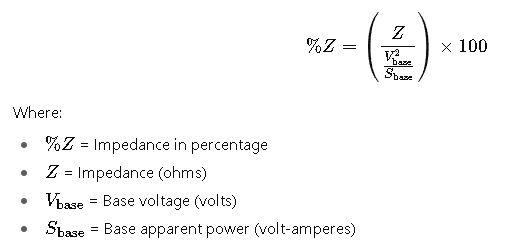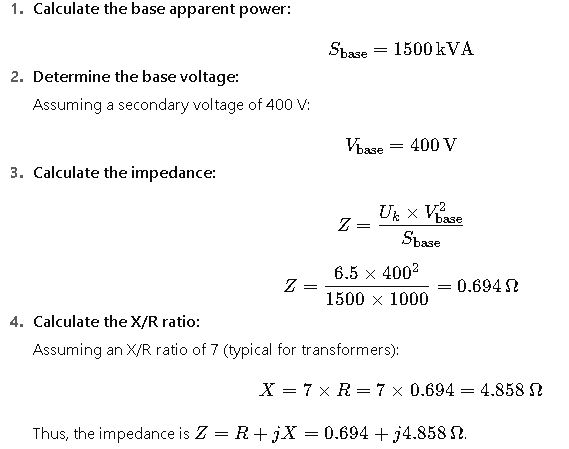Impedance is essential for designing, protecting, and operating electrical systems, ensuring safety and performance reliability. The IEC standardizes impedance calculations for short-circuit studies, equipment ratings, and compliant, accurate system design.
IEC Impedance Z Calculator
What is impedance Z?
Formula used
What PF should I use if unknown?
Common Impedance Values According to IEC Standards
The IEC standardizes impedance values for various electrical components to ensure consistency and safety across installations. Below is a table summarizing typical impedance values for transformers, cables, and generators as per IEC guidelines:
| Component | Impedance (%) | X/R Ratio | IEC Standard Reference |
|---|---|---|---|
| Transformers | |||
| Small Distribution (≤ 100 kVA) | 4–6 | 2–3 | IEC 60076-5 |
| Medium Distribution (100–1000 kVA) | 5–7 | 3–4 | IEC 60076-5 |
| Large Distribution (> 1000 kVA) | 6–8 | 4–5 | IEC 60076-5 |
| Cables | |||
| Low Voltage (≤ 1 kV) | 0.5–1.5 | 1–2 | IEC 60228 |
| Medium Voltage (1–36 kV) | 1.5–3.0 | 2–3 | IEC 60228 |
| High Voltage (> 36 kV) | 3.0–5.0 | 3–4 | IEC 60228 |
| Generators | |||
| Synchronous | 10–15 | 10–15 | IEC 60034-1 |
| Induction | 15–20 | 15–20 | IEC 60034-1 |
Note: These values are indicative and may vary based on specific manufacturer data and installation conditions.
Impedance Calculation Formulas According to IEC
Impedance (Z) in an AC circuit is the total opposition that a circuit presents to alternating current, comprising both resistance (R) and reactance (X). According to IEC standards, the general formula for impedance is:
Where:
- Z = Total impedance (ohms)
- R= Resistance (ohms)
- X= Reactance (ohms)
For short-circuit calculations, the impedance is often expressed as a percentage (%Z) relative to the base apparent power (S_base) and voltage (V_base):

The X/R ratio is a critical parameter in short-circuit analysis, influencing the asymmetry of fault currents. It is calculated as:
IEC standards provide default X/R ratios for various components when specific data is unavailable. For instance, for high-voltage networks (Un > 35 kV), the impedance can be regarded as purely reactive, implying an X/R ratio approaching infinity. In other cases, a distribution of 0.0995 resistive and 0.995 reactive can be assumed, resulting in an X/R ratio of approximately 0.1.
Real-World Application Examples
Example 1: Transformer Impedance Calculation
Consider a 1500 kVA transformer with a short-circuit voltage (U_k) of 6.5%. To calculate the impedance:

Example 2: Cable Impedance Calculation
For a 1 km length of copper cable with a cross-sectional area of 10 mm², operating at 50 Hz:
- Determine the DC resistance:
Using IEC 60228, the DC resistance of copper at 20°C is approximately 3.28 Ω/km. - Calculate the inductive reactance:
The inductive reactance per kilometer for a typical cable is approximately 0.1 Ω/km. - Calculate the total impedance:
4.Calculate the X/R ratio:
This low X/R ratio indicates a predominantly resistive impedance, typical for short cable lengths.
Considerations for Accurate Impedance Calculations
- Temperature Effects:
The resistance of conductors increases with temperature. IEC 60228 provides temperature coefficients to adjust resistance values accordingly. - Frequency Dependence:
Impedance varies with frequency, especially for inductive and capacitive components. It’s essential to consider the operating frequency when calculating impedance. - Component Ratings:
Always refer to the manufacturer’s data for precise impedance values, as they may differ from standard assumptions. - System Configuration:
The configuration of the electrical system (e.g., radial or meshed) can influence impedance calculations, particularly in short-circuit studies.
Frequently Asked Questions (FAQs) – Impedance Z Calculator to IEC
1. What is impedance (Z) in electrical systems?
Impedance is the total opposition that a circuit presents to alternating current. It combines both resistance (R) and reactance (X), which includes inductive and capacitive effects. Impedance determines how current flows in a system and affects voltage drops, power losses, and short-circuit behavior.
2. Why is impedance expressed as a percentage (%Z) in IEC standards?
Percentage impedance provides a standardized way to compare different transformers, cables, and equipment regardless of their rated voltages or powers. It simplifies short-circuit calculations and allows engineers to determine fault currents quickly.
3. What is the significance of the X/R ratio?
The X/R ratio represents the proportion of reactance to resistance in an impedance. It is crucial for calculating asymmetrical short-circuit currents and understanding how quickly currents decay after a fault. Higher X/R ratios indicate predominantly reactive systems, while lower ratios indicate resistive dominance.
4. How are standard impedance values determined?
IEC standards provide typical impedance values based on equipment type, size, and voltage rating. These values are derived from testing, manufacturer specifications, and industry practice to ensure safe and predictable system behavior.



